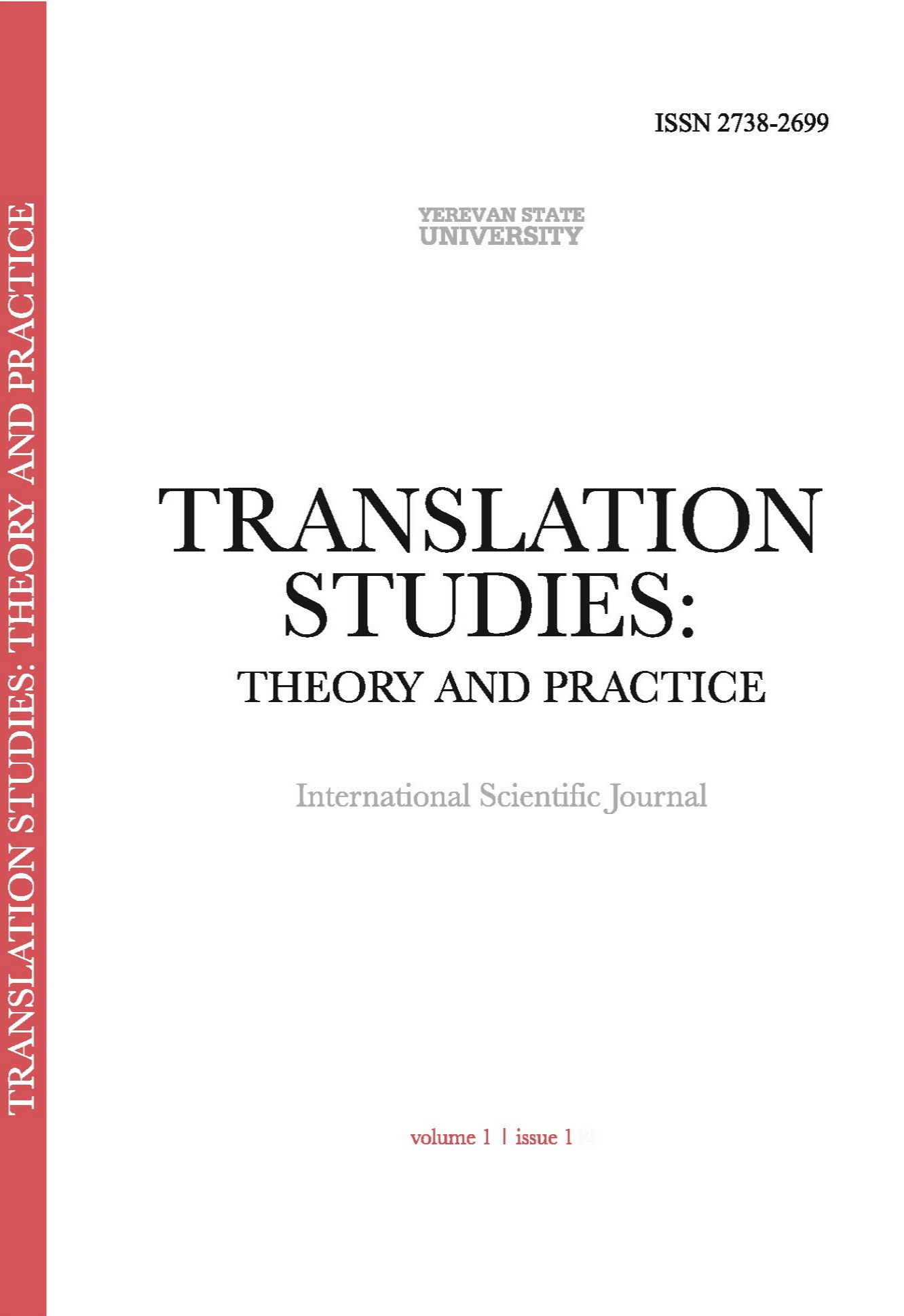Pragmatic Coherence and Equivalence in Literary Translation
DOI:
https://doi.org/10.46991/TSTP/2021.1.1.142Keywords:
cross-cultural pragmatics, illocutionary and perlocutionary acts, cultural translation, cultural context, equivalenceAbstract
The topic of the present paper concerns cultural translation and focuses on the cross-cultural aspect of pragmatic equivalence. It is based on the hypothesis that the pragmatic framework of the literary work, i.e. the deliberate choice of tied verbal actions and the interpretations of these actions, forms an important slot in the overall structure of cultural context and displays the artistic literary idea of the writer. Hence the research work clearly shows that literary translation should adequately transmit the intentions and ideas encoded in the original text to the readers from the respective culture. The cross-cultural pragmatic analysis of the speech act sequences and reporting words carried out on the material of a literary work in English and its Armenian translation has enabled us to determine that the violation of pragmatic coherence of the source text distorts the cultural context planned by the author.
References
Ahearn, Laura M. 2012. Living language: An Introduction to Linguistic Anthropology. USA: Wiley-Blackwell.
Barker Chris, and Dariuzs Galasinski. 2001. Cultural Studies and Discourse Analysis. London: Sage.
Bassnett, Susan. 2002. Translation studies. London: Routledge.
Bharati, Bhasha. 2018. “Understanding the Relationship between Translation and Culture.” In Translation Agency: https://bhashabharati.medium.com/understanding-the-relationship-between-translation-and-culture-92e58803bffb (Accessed: Feb. 8, 2021).
Bingqian, Wang. 1995. The Science of Cultural Translation. Tianjin: The Press of Nankai University.
Blum-Kulka, Shoshana, House, Juliane, and Kasper Gabriele. 1989. Cross-cultural Pragmatics: Requests and Apologies. Norwood, New Jersey: Ablex.
Borkowski, Jan. 2014. “What is the Cultural Context of a Literary Text?” in Journal of Literary Theory Online: http://www.jltonline.de/index.php/¬reviews/-article/view/631/1540 (Accessed: February 25, 2021).
Bradbury, Ray. 1983. Farenheit 451 and Short Stories. Moscow: Raduga Publishers.
Cultural Context. at Quora.com: https://www.quora.com/What-is-the-meaning-of-cultural-context (Accessed: February 25, 2021).
Darnell, Regna. 2001. “Translation.” In Key Terms in Language and Culture. (ed.) A. Duranti, 248-251. USA: Blackwell Publishing.
Dixon, Robert. 2005. A Semantic Approach to English Grammar. Oxford: Oxford University Press.
Geng, Xiao. 2013. “Techniques of the Translation of Culture.” In Theory and Practice in Language Studies. 3:6, 977-981. Academy Publisher. DOI:10.4304/tpls.3.6.977-981.
Goddard Cliff, and Anna Wierzbicka. 2007. “Discourse and Culture.” In Discourse as Social Interaction. (ed.) T.A. van Dijk, 231-258. Los Angeles, London: Sage Publications.
Goodenough, Ward H. 1981. Culture, Language, and Society. Menlo Park, CA.: Cummings.
Larson, Mildred. 1998. Meaning-Based Translation: A Guide to Cross-language Equivalence. Lanham, MD: University Press of America.
Maitland, Sarah. 2017. What is Cultural Translation? London and New York: Bloomsbury Academic.
Newmark, Peter. 1988. A Textbook of Translation. New York: Prentice Hall.
Newmark, Peter. 1991. About Translation. Clevedon: Multilingual Matters.
Paronyan, Shushanik, and Bekaryan, Lilit. 2013. “Verbalization of Interpersonal Conflict in Fiction.” In Studia Filologica: Filologichni Studiya Zborniknaukovikh prats. 2, 60-66. Kiev: Kievskiy Universitet Imeni B. Grichenka.
Paronyan, Shushanik. 2018. “Language Elements of Foreign Culture in the Narrative: A Pragmatic Approach.” In: “Հայագիտության հարցեր» հանդես 1:13.” 153-165. Երևան: ԵՊՀ հրատ.
Riley, Philip. 2007. Language, Culture and Identity. London: Continuum.
Samovar, Larry A., Richard E. Porter, and Edwin R. McDaniel. 2009. Communication between Cultures. Boston: Wadsworth Cengage Learning.
Shaw, Daniel R. 2012. “The Translation Context: Cultural Factors in Translation.” In Translation Review, 23(1), 25-29: https://doi.org/10.1080/073748-36.1987.10523398 (Accessed: February 24, 2021).
Venuti, Lawrence. 1995. The Translator’s Invisibility: A History of Translation. London and New York: Routledge.
Verschueren, Jef. 1999. Understanding Pragmatics. London: Edward Arnold.
Waard, Jan de, and Eugene A Nida. 1986. From One Language to Another: Functional Equivalence in Bible Translation. Tennessee: Thomas Nelson Publishers.
Wenhua, Wang. 2000. Differences and Translation. Changsha: The Press of Zhongnan University.
Wierzbicka, Anna. 2003. Cross-Cultural Pragmatics: The Semanitcs of Social Interaction. Berlin, New York: Mouton de Gruyter.
Wilson Andrew. 2009. Translators on Translating: Inside the Invisible Art. Vancouver: CCSP Press.
Yunxing, Li. 1998. Cultural Factors in Translation. Perspectives, 6:2:175-182: DOI: 10.1080/0907676X.1998.9961334 (Accessed: February 25, 2021).
Bredber, Rey. 2016. Farenhyt' 451. (t'argm.) L.Haroyan. Yerevan: Zangak.
Paronyan, Shushanik. 2011. Lezvach'anachoghut'yun ev diskurs. Yerevan, EPH hrat.
Paronyan, Shushanik. 2014. "Artalezvakan lezvamshakut'ayin gorts'onneri dery banavor t'argmanut'yan gorts'ynt'atsum". T'argmanut'yuny vorpes gitakan usumnasirut'yan ararka ev mijmshakut'ayin p'okhnert'ap'antsman mijots git. hodv. j'ogh., 45-52. Yerevan, YPH hrat.
Paronyan, Shushanik, T'amoyan, Nare. 2016. "Qaghaqavarut'yan kargy ev neroghut'yun haytsely". Banber Yerevani hamalsarani 1, 68-81. Yerevan: YPH hrat.
Downloads
Published
How to Cite
Issue
Section
License
Copyright (c) 2021 Shushanik Paronyan

This work is licensed under a Creative Commons Attribution-NonCommercial 4.0 International License.










